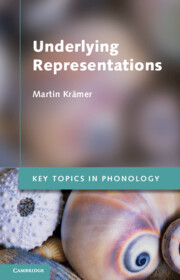Book contents
- Frontmatter
- Contents
- Acknowledgements
- Abbreviations
- 1 Getting started
- 2 Arbitrariness and opposition
- 3 Derivation and abstractness
- 4 Underspecification returns
- 5 The devil is in the detail
- 6 Psycho- and neurolinguistic evidence
- 7 On the form and contents of contrastive features
- 8 Underlying representations in Optimality Theory
- 9 Preliminary results
- Glossary
- Notes
- References
- Name index
- Language index
- Subject index
- References
6 - Psycho- and neurolinguistic evidence
Published online by Cambridge University Press: 05 November 2012
- Frontmatter
- Contents
- Acknowledgements
- Abbreviations
- 1 Getting started
- 2 Arbitrariness and opposition
- 3 Derivation and abstractness
- 4 Underspecification returns
- 5 The devil is in the detail
- 6 Psycho- and neurolinguistic evidence
- 7 On the form and contents of contrastive features
- 8 Underlying representations in Optimality Theory
- 9 Preliminary results
- Glossary
- Notes
- References
- Name index
- Language index
- Subject index
- References
Summary
INTRODUCTION
Traditionally underlying representations were determined on the basis of contrast and of generalizations that can be made about the surface patterns found in a language, as well as on the basis of assumptions about lexical economy. The last two decades, though, have seen a surge of experimental work that tries to reveal the form of underlying representations by subjecting speakers to word games or nonce-word tests. With these techniques forms can be elicited that reveal activity of otherwise static or unobservable patterns and the corresponding generalizations about restrictions on the surface as well as in the lexicon. Other recent studies show aspects of phonological representations by measuring brain activity or reaction times in listening, judgement or lexical decision tasks.
In the following we will look at a few exemplary studies that produce evidence for the form of underlying representations. We will be considering the following aspects of underlying representations: segments that never alternate could be specified differently from their surface form in the redundant features but also in contrastive features. Such divergences can be based on several grounds, either pure lexical economy, a notion that has been challenged repeatedly (see Chapters 3, 5 and 8), or because the contrastive feature is not contrastive in a given environment, or because the contrastive feature is predictable through a process that is operative elsewhere.
- Type
- Chapter
- Information
- Underlying Representations , pp. 128 - 148Publisher: Cambridge University PressPrint publication year: 2012



